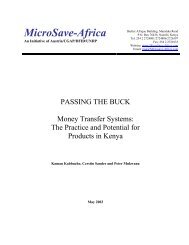Create successful ePaper yourself
Turn your PDF publications into a flip-book with our unique Google optimized e-Paper software.
Barclay could not have known then that within<br />
just a few <strong>years</strong>, <strong>DAI</strong> would more than triple in<br />
size, much <strong>of</strong> its growth fueled by its strong<br />
performance in post-conflict environments. With<br />
that rapid growth came the opportunity to build<br />
the firm’s reputation as a go-to service provider<br />
for USAID in the most difficult settings, and<br />
enhance its leadership role in the development<br />
community.<br />
Working in the Wake <strong>of</strong><br />
Conflict<br />
OTI had been formed with a mandate for flexible<br />
programming because USAID recognized<br />
there was a gap in its toolkit—the gap between<br />
disaster relief delivered on a short-term basis<br />
and longer-term social and economic development<br />
programs. Like other donor agencies,<br />
its business model was not equipped to help<br />
countries through the complex transition period<br />
after conflict ceased, when political, social, and<br />
economic structures were shaky and early gains<br />
could soon be lost. These situations required<br />
immediate funding—much faster than the traditional<br />
project planning cycle—and increased<br />
flexibility, as it would be impossible to know in<br />
advance exactly where to allocate funds and<br />
which local organizations merited support. OTI’s<br />
Barton compared his new approach to venture<br />
capital investing, because it put a premium on<br />
creativity and prudent risk-taking by OTI’s team<br />
and its implementing partners. <strong>DAI</strong> quickly embraced<br />
the concept.<br />
Photo by Orin Hassan, <strong>DAI</strong><br />
<strong>DAI</strong>’s informal presentation in Barton’s <strong>of</strong>fice<br />
went well, probably because there were experienced<br />
Congo hands on both sides <strong>of</strong> the table.<br />
Although <strong>DAI</strong> had proposed to run just one <strong>of</strong><br />
the four or five regional <strong>of</strong>fices in the new Congo<br />
program, OTI told Barclay, “Yours was the<br />
only group that demonstrated both knowledge<br />
and a genuine affection for the country, so we’re<br />
asking you to manage the whole program.” Just<br />
two weeks after the contract was signed, the<br />
first members <strong>of</strong> <strong>DAI</strong>’s project team (including<br />
several who had done Peace Corps service in<br />
Congo) arrived in country, fanned out to open<br />
four regional <strong>of</strong>fices, and began engaging local<br />
organizations to develop ready-made projects<br />
for OTI grant funding. Soon funds were being<br />
disbursed and grants implemented at a pace<br />
and scale that dwarfed previous OTI efforts in<br />
other countries.<br />
SWIFT projects could<br />
involve a wide variety<br />
<strong>of</strong> work—the key was<br />
to cooperate with<br />
local citizens and act<br />
quickly.<br />
67



